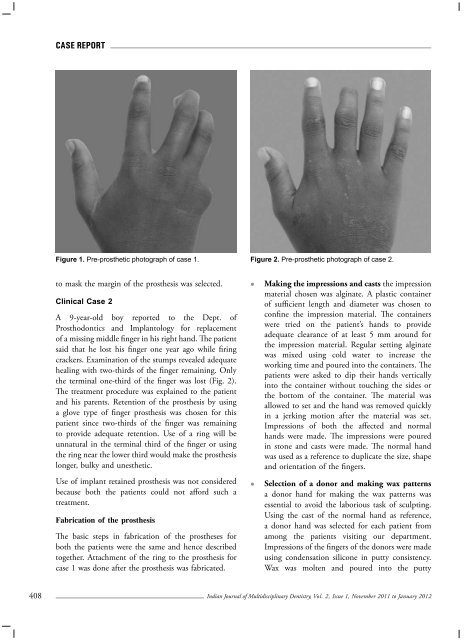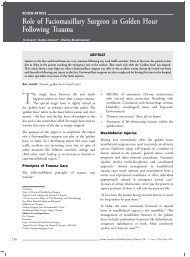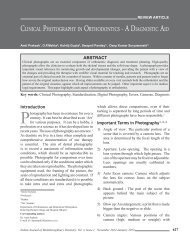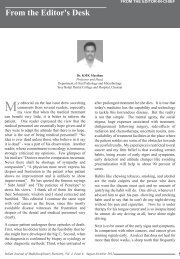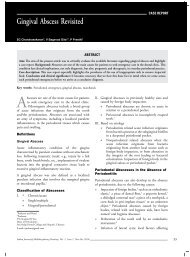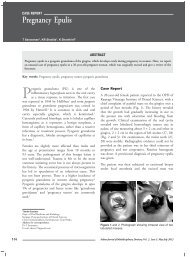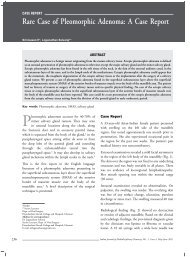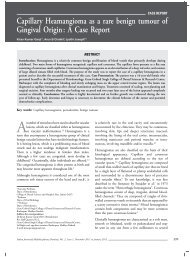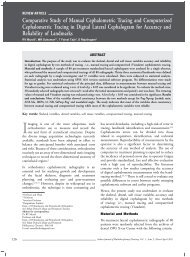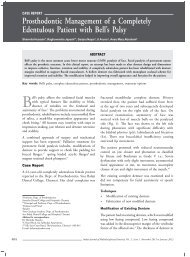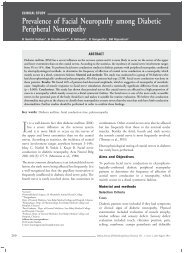Volume 2 - Issue 1 (Nov-Jan) - IJMD
Volume 2 - Issue 1 (Nov-Jan) - IJMD
Volume 2 - Issue 1 (Nov-Jan) - IJMD
Create successful ePaper yourself
Turn your PDF publications into a flip-book with our unique Google optimized e-Paper software.
Case ReportFigure 1. Pre-prosthetic photograph of case 1. Figure 2. Pre-prosthetic photograph of case 2.to mask the margin of the prosthesis was selected.Clinical Case 2A 9-year-old boy reported to the Dept. ofProsthodontics and Implantology for replacementof a missing middle finger in his right hand. The patientsaid that he lost his finger one year ago while firingcrackers. Examination of the stumps revealed adequatehealing with two-thirds of the finger remaining. Onlythe terminal one-third of the finger was lost (Fig. 2).The treatment procedure was explained to the patientand his parents. Retention of the prosthesis by usinga glove type of finger prosthesis was chosen for thispatient since two-thirds of the finger was remainingto provide adequate retention. Use of a ring will beunnatural in the terminal third of the finger or usingthe ring near the lower third would make the prosthesislonger, bulky and unesthetic.Use of implant retained prosthesis was not consideredbecause both the patients could not afford such atreatment.Fabrication of the prosthesisThe basic steps in fabrication of the prostheses forboth the patients were the same and hence describedtogether. Attachment of the ring to the prosthesis forcase 1 was done after the prosthesis was fabricated.• Making the impressions and casts the impressionmaterial chosen was alginate. A plastic containerof sufficient length and diameter was chosen toconfine the impression material. The containerswere tried on the patient’s hands to provideadequate clearance of at least 5 mm around forthe impression material. Regular setting alginatewas mixed using cold water to increase theworking time and poured into the containers. Thepatients were asked to dip their hands verticallyinto the container without touching the sides orthe bottom of the container. The material wasallowed to set and the hand was removed quicklyin a jerking motion after the material was set.Impressions of both the affected and normalhands were made. The impressions were pouredin stone and casts were made. The normal handwas used as a reference to duplicate the size, shapeand orientation of the fingers.• Selection of a donor and making wax patternsa donor hand for making the wax patterns wasessential to avoid the laborious task of sculpting.Using the cast of the normal hand as reference,a donor hand was selected for each patient fromamong the patients visiting our department.Impressions of the fingers of the donors were madeusing condensation silicone in putty consistency.Wax was molten and poured into the putty408Indian Journal of Multidisciplinary Dentistry, Vol. 2, <strong>Issue</strong> 1, <strong>Nov</strong>ember 2011 to <strong>Jan</strong>uary 2012


